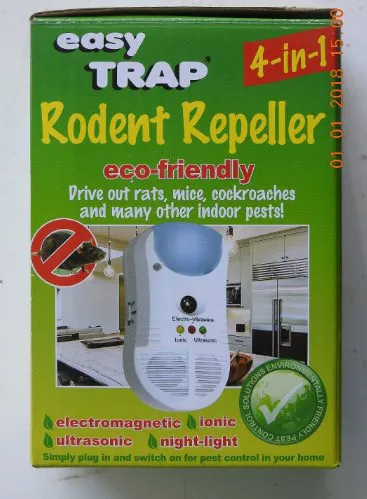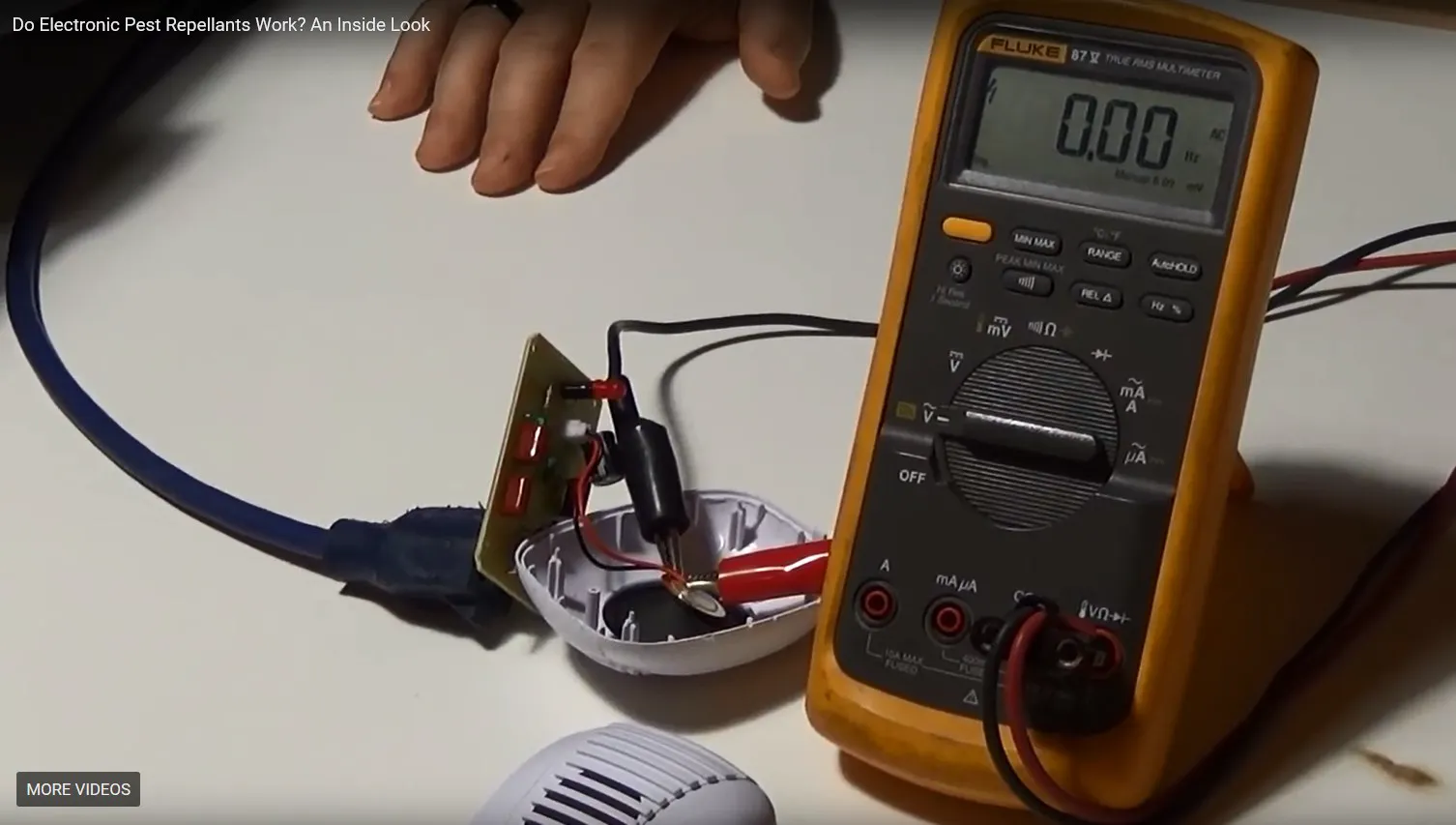Product review: Easy Trap Rodent Repeller
Robin Bodley - 1st May 2018
I have wanted to get my grubby hands on one of these for some time, so on New Years day I went to Bunnings and deliberately wasted $30 (sale price) on a device that I didn’t think would work as advertised. The product website sells it for $90.
After unboxing I took the case apart to take some photos and trace the circuits of the functions of interest. Having spotted the thyristor, or SCR (silicon controlled rectifier), I needed to know what is going on inside the 8 pin chip.

I initially wondered what the largish 2K resistor was for and why there was no reverse bias blocking diode in series with the gate, but relegated those thoughts to the back of my mind.
So I set up a rough and ready test using a coil out of a CRT deflection yoke to sense the external magnetic field. Also, for giggles, I placed a magnetic compass near it.
The top waveform in photo 14, I’ll call it P14, is the voltage across the sniffer coil and the bottom waveform is the mains voltage for reference. Note that the sniffer coil voltage is proportional to the rate of change of the magnetic flux. This waveform had me puzzled, why is it so squiggly?
So it was out with the isolating transformer to enable direct probing of the circuit. The bottom waveform in P17 is the voltage across coil L1 in the schematic P11. The ground reference is the left hand end of the coil so the waveform appears inverted. The top waveform is the mains voltage. Now if the SCR was acting as a diode the waveform would be a half sinusoid, but it is badly distorted and the fuzzy smudge indicates a parasitic oscillation. P18 is an expanded view of the fuzzy bit, the time-base is set to 0.2 μs/div. Do the sums and it looks like 1500 kHz, and as predicted a radio tuned to the top of the AM broadcast band picks it up.
Two more tests. The SCR was removed and a diode substituted, see P15, and the SCR was reconnected but with a blocking diode in series with the gate, see P22. In both cases the sniffer coil waveform was relatively undistorted, see P16, and there was no parasitic oscillation.
The SCR in normal operation cannot be turned off once triggered by applying reverse bias to the gate. This circuit demonstrates this. But if you want an efficient oscillator you use a device that can be turned off. In fact in a class C amplifier the active device spends more than half its time turned off.
So, this device is generating radio frequency interference, RFI, but don’t worry, in the circuit P11 you will notice a capacitor labelled 0.1 μF 275 V AC, that is an RFI suppressor that prevents the RFI from propagating through the mains wiring. Also if the radio is moved a metre away it picks up nothing, but it picks a little bit of RFI from my F&P washing machine which is in the next room. Near Field radiation attenuation follows an inverse cube law.
What does the 8 pin chip do?
When the red LED is on the pin driving the SCR gate circuit puts out 5V and when the LED is off it puts out 0V. If that is their idea of Digital Signal Processing (DSP), it’s a joke.
So there you have it “Electro-Vibrawave™ technology”
“Sends digitally-processed magnetic pulses through the existing wiring in the walls of your home where rodents nest and breed.”
What about the other functions?
The night light works.
I can smell a small amount of ozone coming from the grill.
The ultrasonic transducer (speaker) is driven by a 25kHz waveform, which is in the hearing range of most domestic pets. If pets are not bothered by 25kHz why would unwanted rodents be?
Bunnings Wellington dropped the price to $15 and are now out of stock.
Mitre 10 has a competing product.
https://www.mitre10.co.nz/shop/pestrol-rodent-free-125mm/p/274719
But wait there is more:
Robin replied to his post with a link to a Youtube video entitled “Do Electronic Pest Repellents Work? An Inside Look” by Roger Merchant, Electrical Engineer
https://www.youtube.com/watch?v=Fsp508ZJaVU
Summary:
In the video Roger took one of the devices apart and concluded that the primary function of the circuit was to make the LED pulse. He used a measuring tool and found no voltage was coming to the speaker at all, so the device wasn’t producing any output or a frequency and therefore nothing was being radiated out to bother the mice. He ends the post by saying simply this product does not work according to its claims.

Roger Merchant confirming no vaults were detected going to the speaker
The Easy Trap Rodent Repeller
10 features worth thinking about:
-
Makes you feel kind to small creatures (effect wears off as your skepticism increases).
-
Makes an ozone smell (that rain smell) - Ozone can worsen respiratory illnesses like asthma.
-
The night light works although it wouldn’t be bright enough to read by or to keep the monsters away for young children.
-
Makes money for the manufacturer.
-
Does not harm rats, mice, cockroaches and many other indoor pests.
-
Makes money for the distributor.
-
Does not deter rats, mice, cockroaches and many other indoor pests.
-
The font it uses to tell you about the things it cannot do is large, legible and friendly.
-
It uses alliteration to appeal to consumers who like that kind of thing.
-
It’s an easy trap to fall into to buy one of these.
Activism:
If you would like to know more about how DOC controls pests in the wild with the aim of making NZ predator free by 2050, see www.doc.govt.nz and type “choose traps and toxins” into their search engine.
Do you know of a product that you think should be put under the spotlight? Let us know at editor@skeptics.nz